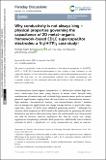| dc.contributor.author | Borysiewicz, Michał Adam | |
| dc.contributor.author | Dou, Jinhu | |
| dc.contributor.author | Stassen, Ivo | |
| dc.contributor.author | Dinca, Mircea | |
| dc.date.accessioned | 2021-12-17T18:57:30Z | |
| dc.date.available | 2021-10-27T20:24:32Z | |
| dc.date.available | 2021-12-17T18:57:30Z | |
| dc.date.issued | 2021 | |
| dc.identifier.uri | https://hdl.handle.net/1721.1/135666.2 | |
| dc.description.abstract | The physical properties of the 2D MOF Ni<jats:sub>3</jats:sub>(HITP)<jats:sub>2</jats:sub> synthesized in batches under different conditions are analysed to understand which variables govern the capacitive behaviour of supercapacitor electrodes prepared using the neat MOF material. | en_US |
| dc.language.iso | en | |
| dc.publisher | Royal Society of Chemistry (RSC) | en_US |
| dc.relation.isversionof | 10.1039/d1fd00028d | en_US |
| dc.rights | Creative Commons Attribution Noncommercial 3.0 unported license | en_US |
| dc.rights.uri | https://creativecommons.org/licenses/by-nc/3.0/ | en_US |
| dc.source | Royal Society of Chemistry (RSC) | en_US |
| dc.title | Why conductivity is not always king – physical properties governing the capacitance of 2D metal–organic framework-based EDLC supercapacitor electrodes: a Ni 3 (HITP) 2 case study | en_US |
| dc.type | Article | en_US |
| dc.contributor.department | Massachusetts Institute of Technology. Department of Chemistry | en_US |
| dc.relation.journal | Faraday Discussions | en_US |
| dc.eprint.version | Final published version | en_US |
| dc.type.uri | http://purl.org/eprint/type/JournalArticle | en_US |
| eprint.status | http://purl.org/eprint/status/PeerReviewed | en_US |
| dc.date.updated | 2021-08-05T13:37:42Z | |
| dspace.orderedauthors | Borysiewicz, MA; Dou, J-H; Stassen, I; Dincă, M | en_US |
| dspace.date.submission | 2021-08-05T13:37:44Z | |
| mit.journal.volume | 231 | en_US |
| mit.journal.issue | 0 | en_US |
| mit.license | PUBLISHER_CC | |
| mit.metadata.status | Publication Information Needed | en_US |
